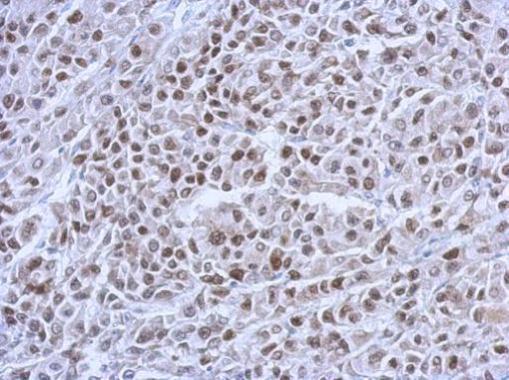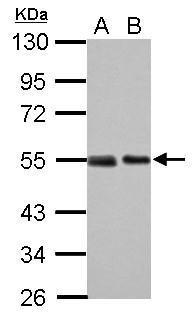Anti-p53 Antibody (3340)
Anti-p53 Antibody (3340)
Product No.: 3340
- -
- -
Clone 240 Target p53 Formats AvailableView All Product Type Monoclonal Alternate Names Antigen NY-CO-13, Phosphoprotein p53, Tumor suppressor p53 Isotype Mouse IgG1 Applications ELISA , FACS , ICC , IF , IHC FF , IHC FFPE , IP , WB |
Data
 Sample (30 ug of whole cell lysate)
A: HCT116 cells with mock treatment for 24 hr
B: HCT116 cells with 30 uM cisplatin treatment for 24 hr
10% SDS PAGE
3340 diluted at 1:1000
The HRP-conjugated anti-mouse IgG antibody was used to detect the primary antibody.
Sample (30 ug of whole cell lysate)
A: HCT116 cells with mock treatment for 24 hr
B: HCT116 cells with 30 uM cisplatin treatment for 24 hr
10% SDS PAGE
3340 diluted at 1:1000
The HRP-conjugated anti-mouse IgG antibody was used to detect the primary antibody. - -
- -
Antibody DetailsProduct DetailsReactive Species Human Host Species Mouse Immunogen Gel-purified p53 containing aa 14-389 of human p53. Product Concentration Lot Specific Formulation PBS, pH 7.4 State of Matter Liquid Product Preparation Purified by Protein G affinity chromatography Storage and Handling This antibody is stable for at least one (1) year at -20°C. Avoid multiple freeze-thaw cycles. Regulatory Status Research Use Only Country of Origin USA Shipping Next Day 2-8°C Applications and Recommended Usage? Quality Tested by Leinco ELISA, FACS, IHC (frozen and paraffin), Immunoprecipitation, Immunoblotting.
IHC: use at 2-4ug/ml. Extensive washing may be necessary. Protein digestion and/or microwave antigen retrieval prior to staining is not required. #3340 on paraffin-embedded HBL435 xenograft. Immunoprecipitation: use at 10ug/mg of lysate. This antibody reacts only with mutant p53 under non-denaturing conditions. Immunoblotting: use at 5-10ug/ml. A band of 53kDa is detected. #3340 on 30ug of 293T (A) and A431 (B) cell lysates. These are recommended concentrations. Enduser should determine optimal concentrations for their applications. Each investigator should determine their own optimal working dilution for specific applications. See directions on lot specific datasheets, as information may periodically change. DescriptionDescriptionSpecificity This antibody recognizes human, mouse, and dog p53. Background p53 is a tumor suppressor protein that is mutated in a wide variety of cancers. p53 is a nuclear
protein that mediates cell cycle arrest in response to DNA damage which is important in
maintaining genomic stability. Function Acts as a tumor suppressor in many tumor types; induces growth arrest or apoptosis depending on the physiological circumstances and cell type. Involved in cell cycle regulation as a trans-activator that acts to negatively regulate cell division by controlling a set of genes required for this process. One of the activated genes is an inhibitor of cyclin-dependent kinases. Apoptosis induction seems to be mediated either by stimulation of BAX and FAS antigen expression, or by repression of Bcl-2 expression. Its pro-apoptotic activity is activated via its interaction with PPP1R13B/ASPP1 or TP53BP2/ASPP2 (PubMed:12524540). However, this activity is inhibited when the interaction with PPP1R13B/ASPP1 or TP53BP2/ASPP2 is displaced by PPP1R13L/iASPP (PubMed:12524540). In cooperation with mitochondrial PPIF is involved in activating oxidative stress-induced necrosis; the function is largely independent of transcription. Induces the transcription of long intergenic non-coding RNA p21 (lincRNA-p21) and lincRNA-Mkln1. LincRNA-p21 participates in TP53-dependent transcriptional repression leading to apoptosis and seems to have an effect on cell-cycle regulation. Implicated in Notch signaling cross-over. Prevents CDK7 kinase activity when associated to CAK complex in response to DNA damage, thus stopping cell cycle progression. Isoform 2 enhances the transactivation activity of isoform 1 from some but not all TP53-inducible promoters. Isoform 4 suppresses transactivation activity and impairs growth suppression mediated by isoform 1. Isoform 7 inhibits isoform 1-mediated apoptosis. Regulates the circadian clock by repressing CLOCK-ARNTL/BMAL1-mediated transcriptional activation of PER2 (PubMed:24051492). {PubMed:11025664, PubMed:12524540, PubMed:12810724, PubMed:15186775, PubMed:15340061, PubMed:17317671, PubMed:17349958, PubMed:19556538, PubMed:20673990, PubMed:20959462, PubMed:22726440, PubMed:24051492, PubMed:9840937}. NCBI Gene Bank ID UniProt.org Research Area Cancer Research References & CitationsTechnical ProtocolsCertificate of Analysis |




